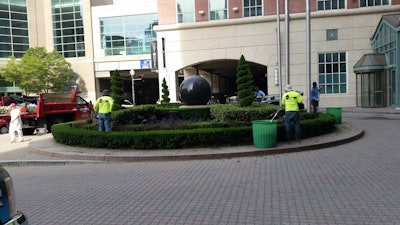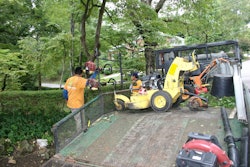
Detail work such as pruning presents a challenge for many lawn maintenance contractors. Some experts say it’s better to simply have your regular maintenance crew do all of the detailing on the sites they manage. Other landscape maintenance experts, such as Tommy Ganz, prefer to have a dedicated detail crew handle this type of work.
When Ganz ran a landscaping company in Florida, detail crews visited properties weekly. In slower-growing parts of the country, detail crews might hit each property once a month. It all depends on the needs of a given property.
Regardless, since the dedicated detail crew—which might even be a one-man crew—is on a property so frequently, he may only prune selected areas each visit. He’s also “snipping” as opposed to “heavy trimming”. He can move faster and more precisely, and his cleanup time is reduced considerably.
If you do elect to have your maintenance crews take care of the detail work, Ganz says 10 to 15 minutes of light snipping each visit is a good approach, at least when it comes to high-end residential.
When it comes to pricing and contracts, Ganz says he typically combines detail work into pricing, especially on residential properties. Should a property have “extensive detail and gardening requirements,” they will isolate the pricing. “That gives us the flexibility to alter the program during the contract period,” Ganz points out.
Pricing detail work is one of the most difficult tasks to develop a production ratio for, since no two ornamentals are the same, especially in mature landscapes. Ganz says you have to closely document your detail work man-hours as you perform them. Be sure to collect the following data:
- How long it takes to prune a certain plant
- The size category of that plant
- How many prunings are necessary to maintain this plant’s shape during the season
“Do the same thing with large or unique ornamentals,” Ganz adds. “For those residential properties with expansive perennial beds, document how long it takes to go into that bed and pinch-off dead blooms, along with how often you have to do it. These are all tasks you can develop production ratios for—but it’s quite tedious. However, the payoff is accurate estimating, accurate job tracking and increased profitability.”













![Gravely Pro Turn Mach One My23 Dsc03139 Edit 1200x800 5b2df79[1]](https://img.greenindustrypros.com/mindful/acbm/workspaces/default/uploads/2025/10/gravely-pro-turn-mach-one-my23-dsc03139-edit-1200x800-5b2df791.BucBnDoN22.jpg?ar=16%3A9&auto=format%2Ccompress&fit=crop&h=135&q=70&w=240)





